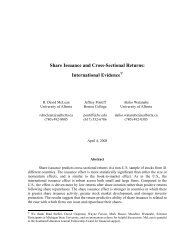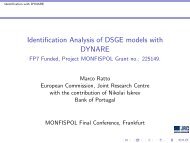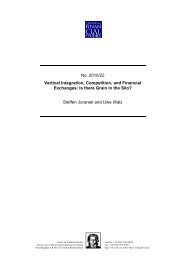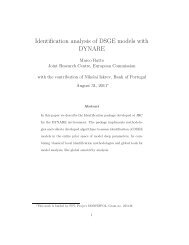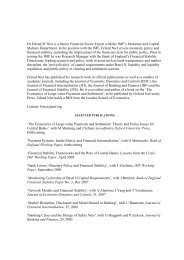Forecasting and Policy Making (Paper) - Center for Financial Studies
Forecasting and Policy Making (Paper) - Center for Financial Studies
Forecasting and Policy Making (Paper) - Center for Financial Studies
You also want an ePaper? Increase the reach of your titles
YUMPU automatically turns print PDFs into web optimized ePapers that Google loves.
continuation in negative territory, because they are linear models. The zero-lower bound on nominal<br />
interest rates requires the incorporation of a nonlinear constraint in the time series models. We will<br />
revisit this question in section 5.6. For 2010 <strong>and</strong> 2011 the interest rate is projected to increase. How-<br />
ever, a <strong>for</strong>ecaster who uses the estimated rule with FOMC <strong>for</strong>ecasts from section 4 to project interest<br />
rates based on longer-run <strong>for</strong>ecasts would have expected that the Federal Reserve would keep interest<br />
rates on this level a bit longer.<br />
Achieving accurate <strong>for</strong>ecasts <strong>for</strong> output growth <strong>and</strong> inflation is even more difficult, because these<br />
time series are less persistent. Neither model predicts the large recession following the global financial<br />
crisis. The output growth <strong>for</strong>ecasts are strongly mean reverting <strong>and</strong> thus not suitable <strong>for</strong> an accurate<br />
prediction of turning points.<br />
The Bayesian VAR provides empirical evidence on the dynamic interdependence between the<br />
four macroeconomic variables, while the autoregressive process captures central dynamics of indi-<br />
vidual time series. The example shows, however, that a certain degree of judgement is necessary to<br />
adjust the <strong>for</strong>ecasts. An advantage of these methods is that the <strong>for</strong>ecasts are just based on a few past<br />
observations <strong>and</strong> thus easy to underst<strong>and</strong> <strong>and</strong> to adjust. The disadvantage of both methods is that no<br />
causal interpretation can be given <strong>and</strong> that the <strong>for</strong>ecasts do not give any in<strong>for</strong>mation about underlying<br />
structural sources of the projections.<br />
5.2 Computing <strong>for</strong>ecasts using structural models<br />
Be<strong>for</strong>e investigating <strong>for</strong>ecasts from a particular structural model, we first give a short overview of the<br />
main steps taken in generating a model-based <strong>for</strong>ecast. In doing so we closely follow the exposition<br />
in Wiel<strong>and</strong> <strong>and</strong> Wolters (2011). Structural macroeconomic models typically include unobservable<br />
variables such as, <strong>for</strong> example, an output gap. A convenient tool <strong>for</strong> estimating such unobservables<br />
is the Kalman filter. With regard to the <strong>for</strong>ecasting process three aspects are best distinguished <strong>and</strong><br />
discussed separately: (i) model specification <strong>and</strong> solution; (ii) parameter estimation; (iii) <strong>and</strong> the<br />
sequence of steps necessary to generate quarter-by-quarter <strong>for</strong>ecasts. In the description of these steps<br />
we will focus here on models estimated with Bayesian techniques.<br />
Model specification <strong>and</strong> solution<br />
A simple New-Keynesian model such as the one estimated by Del Negro <strong>and</strong> Schorfheide (2004)<br />
serves as a good example. It is a log-linearized approximation of the original nonlinear model con-<br />
sisting of three equations: a New-Keynesian IS equation that is derived from the household’s inter-<br />
temporal first-order condition, a New-Keynesian Phillips curve that is implied by the price-setting<br />
problem of the firm under monopolistic competition <strong>and</strong> price rigidity, <strong>and</strong> the central bank’s interest<br />
rate rule:<br />
xt = Etxt+1 − τ −1 (Rt − Etπt+1) + (1 − ρg)gt + ρzτ −1 zt (16)<br />
πt = βEtπt+1 + κ(xt − gt) (17)<br />
Rt = ρRRt−1 + (1 − ρR)(ψ1πt + ψ2xt) + ǫR,t (18)<br />
36



